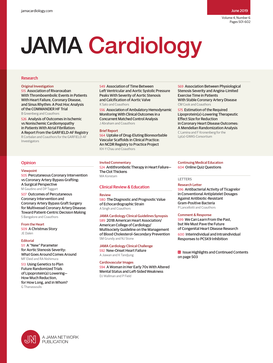Approach to the Postmarket Evaluation of Consumer Wearable Technologies.
IF 14.1
1区 医学
Q1 CARDIAC & CARDIOVASCULAR SYSTEMS
引用次数: 0
Abstract
Importance Consumer wearable technologies have wide applications, including some that have US Food and Drug Administration clearance for health-related notifications. While wearable technologies may have premarket testing, validation, and safety evaluation as part of a regulatory authorization process, information on their postmarket use remains limited. The Stanford Center for Digital Health organized 2 pan-stakeholder think tank meetings to develop an organizing concept for empirical research on the postmarket evaluation of consumer-facing wearables. Observations The postmarket evaluation of consumer wearables involves broad consideration of an individual consumer's journey from acquisition, intended and unintended use of the wearable, and access to health care resources on receipt of a notification. For individuals who do access the health care system, a wearable's downstream effects can be studied through appropriate clinical evaluation, delivery of guideline-directed treatments, shared decision-making in areas of clinical equipoise, and analysis of clinical end points and patient harms. Effective postmarket research draws from denominators appropriate to the clinical question, with clearly defined parameters for success and failure. Generalizability related to data completeness and reliability should also be considered. As patients increasingly integrate wearables into their health monitoring, cross-platform data sharing with a focus on privacy and data quality can drive patient-centered innovation and identify opportunities to bridge gaps in medical care. Relevance The think tank identified priorities in postmarket research, comprising the journey from consumer to patient and accounting for patient, clinician, health care delivery system, and societal impacts of consumer wearables. Overall, this approach serves not only to organize the study of consumer wearables but also to act as a guidepost for using real-world data in postmarket research.消费者可穿戴技术的上市后评估方法
消费者可穿戴技术具有广泛的应用,包括一些获得美国食品和药物管理局批准的健康相关通知。虽然可穿戴技术可能有上市前测试、验证和安全评估作为监管授权过程的一部分,但其上市后使用的信息仍然有限。斯坦福数字健康中心组织了两次泛利益相关者智库会议,以开发面向消费者的可穿戴设备上市后评估的实证研究组织概念。消费者可穿戴设备的上市后评估涉及广泛考虑个人消费者从购买、有意和无意使用可穿戴设备到收到通知后获得医疗保健资源的过程。对于使用医疗保健系统的个人,可穿戴设备的下游影响可以通过适当的临床评估、指导治疗的提供、临床平衡领域的共同决策以及临床终点和患者危害的分析来研究。有效的上市后研究从适合临床问题的分母中提取,具有明确定义的成功和失败参数。还应考虑与数据完整性和可靠性相关的概括性。随着患者越来越多地将可穿戴设备集成到他们的健康监测中,注重隐私和数据质量的跨平台数据共享可以推动以患者为中心的创新,并找到弥合医疗保健差距的机会。该智库确定了上市后研究的优先事项,包括从消费者到患者的旅程,以及对患者、临床医生、医疗保健服务系统和消费者可穿戴设备的社会影响的考虑。总的来说,这种方法不仅可以组织对消费者可穿戴设备的研究,还可以作为在上市后研究中使用真实世界数据的路标。
本文章由计算机程序翻译,如有差异,请以英文原文为准。
求助全文
约1分钟内获得全文
求助全文
来源期刊

JAMA cardiology
Medicine-Cardiology and Cardiovascular Medicine
CiteScore
45.80
自引率
1.70%
发文量
264
期刊介绍:
JAMA Cardiology, an international peer-reviewed journal, serves as the premier publication for clinical investigators, clinicians, and trainees in cardiovascular medicine worldwide. As a member of the JAMA Network, it aligns with a consortium of peer-reviewed general medical and specialty publications.
Published online weekly, every Wednesday, and in 12 print/online issues annually, JAMA Cardiology attracts over 4.3 million annual article views and downloads. Research articles become freely accessible online 12 months post-publication without any author fees. Moreover, the online version is readily accessible to institutions in developing countries through the World Health Organization's HINARI program.
Positioned at the intersection of clinical investigation, actionable clinical science, and clinical practice, JAMA Cardiology prioritizes traditional and evolving cardiovascular medicine, alongside evidence-based health policy. It places particular emphasis on health equity, especially when grounded in original science, as a top editorial priority.
 求助内容:
求助内容: 应助结果提醒方式:
应助结果提醒方式:


